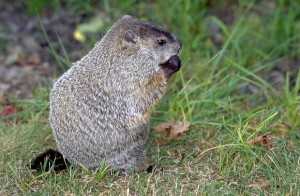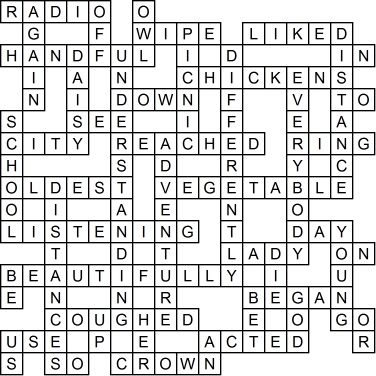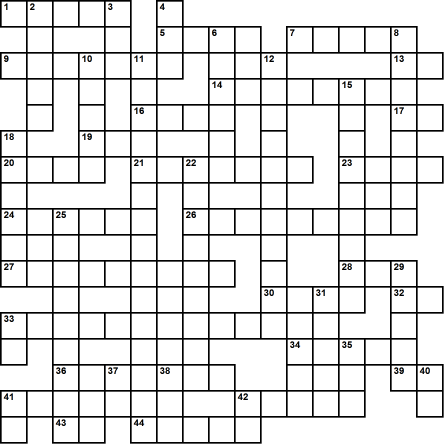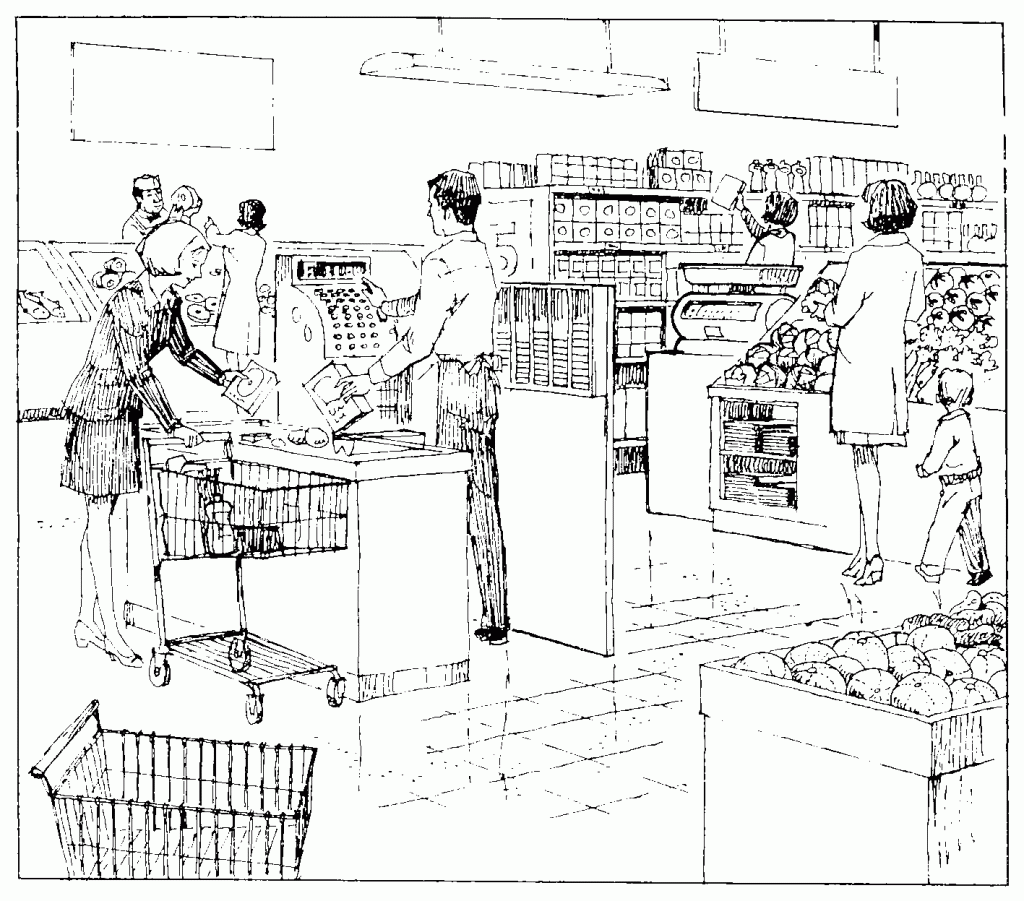Blog Archives
Easy Crossword 1 (Solution)
Easy Crossword 1
Here is a crossword with some general vocabulary. Give it a try and see how you do. Solution next time.
Across
1. You use this to listen to music or news
5. To erase or clean
7. That was a good movie; I ____ it.
9. When your hands are not empty, you have a _____
13. Opposite of “out”
14. Farm birds that lay eggs
16. Opposite of “up”
17. A preposition
19. To use your eyes
20. A place like Chicago
21. By standing on his toes, he _____ the book on the top shelf.
23. Finger jewelry
24. Opposite of “youngest”
26. A plant that can be eaten is a fruit or _____
27. Using your ears
28. When the sun shines
30. Woman
32. Opposite of “off”
33. Prettily
34. Started
36. What you often do when you have a cold
39. Opposite of “come”
41. Please _____ a pen to write your name
42. Performed in a play or movie
43. Because, since
44. What a king wears on his head
Down
2. When you repeat something, you do it ______
3. Opposite of “on”
4. A night bird
6. Eating out in a park
8. From far away
10. A flower with white petals and yellow center
11. Knowing the meaning of something
12. Not in the same way
15. All people
18. Where you go to learn
22. An exciting trip
25. Separations between places
29. Opposite of “old”
31. Opposite of “born”
33. “_____” verbs and “do” verbs are two basic kinds of verbs
34. Gamble (win money in a game)
35. Divine being
37. Opposite of “down”
38. Pronoun for a female
40. Two important conjunctions are “and” and “_____”
41. Plural pronoun
42. English articles are “the,” “a,” and “_____”
Idiom Focus: Animal Idioms 7
Every Saturday I’ll give you a couple of idioms to learn. An idiom is a saying or phrase whose meaning cannot be taken from the literal meanings of the words.
cry wolf: to pretend that you are in danger when you are not; give a false alarm. This idiom comes from Aesop’s fable about the boy who cried wolf – each time he yelled that a wolf was attacking his sheep, all the villagers came running to help him fight the wolf. They were angry at the boy for fooling them about the wolf, so when he really did see a wolf, no one came when he cried for help.
Example:
Stop crying wolf. If you continue to say that a bully is harassing you when he really isn’t, no one will believe you when it does happen.
curiosity killed the cat: People who are curious and wonder about things that are none of their business will get into trouble (create problems for themselves).
Example:
Mind your own business and don’t worry about what other people are doing. Curiosity killed the cat.
Writing Assignment: The Grocery Store (Solution)
1. What does the word “groceries” mean?
The word “groceries” refers to foodstuffs that you buy from a grocer.
2. What do you buy in this store?
In this store you can buy fruits, vegetables, meat, bread, canned goods, and packaged goods.
3. Who usually goes grocery shopping more often, men or women?
Women usually go grocery shopping more often than men.
4. What kind of fruit do you see in the foreground?
In the foreground you can see some type of pumpkin or squash.
5. What kind of vegetables do you see in this picture?
The vegetables we can see in this picture are cabbage, celery, and tomatoes.
6. Where are the paper bags?
The paper bags are under the counter.
7. Who is following the woman on the right?
A little boy is following the woman on the right.
8. What do you do with the scale?
With the scale we can weigh fruits and vegetables.
9. Which aisle has a sign hanging over it?
Aisle five has a sign hanging over it.
10. Who is standing at the cash register?
The checkout clerk (cashier) is standing at the cash register.
11. Where are the cigarettes?
The cigarettes are behind the cashier to his right.
12. Who is paying?
A woman is paying for her groceries.
13. How many shelves do you see in aisle five?
We see five shelves in aisle five, including the top shelf.
14. Is the woman in aisle five holding a box or a tin can?
The woman in aisle five is holding a box.
15. Does each woman in the picture have a shopping cart?
No, the only woman we see with a shopping cart is the woman at the checkout.
16. What does the butcher sell?
The butcher sells meat.
17. Can you buy fish in this store?
Yes, we can also buy fish from the butcher.
18. Where do you usually go after you go grocery shopping?
After we go grocery shopping, we usually go home.
19. Are you allowed to take the shopping cart home with you?
No, we are not allowed to take the shopping cart home with us.
20. Is this grocery store in a shopping center or in a small village?
This grocery store is probably not in a small village, but in a shopping center.
Paragraph: A Visit to the Grocery Store
Write a short paragraph about what you do when you go to the grocery store.
You go to the grocery store to buy fruits, vegetables, meats, and various packaged goods that you need for cooking and eating. After you park your car in the parking lot, you go inside the store and take a shopping cart. You go up and down the various aisles looking for the things that you need to get on this shopping trip.
It is usually a good idea to make a shopping list before you go to the store. If you make a list first, you know exactly what you need to get, and you won’t be so tempted to buy things you don’t really need. It is also a good idea not to shop when you are hungry. If you shop when you’re hungry, you usually buy things that are not on your list. This is known as impulse buying. Shopping with a list, and shopping when you’re not hungry, are good ways to avoid impulse buying.
Many people go grocery shopping once a week. Different stores have weekly sales, so it is also a good idea to plan what you buy to take advantage of the sales. Saturdays are busy days when more people go grocery shopping, so some people prefer to shop during off-peak times. Many supermarkets are open 24 hours a day, 7 days a week, so it is easy to pick a time to go grocery shopping that is convenient for you.
After you’ve gotten all the groceries that you need, you go to the checkout. If the store is crowded, you might have to look around to see which checkout lane is the shortest. When it’s your turn, you put all your groceries on the conveyor belt and wait for the cashier to ring them up. Most stores now have a scanner, so instead of entering the prices by hand at the cash register, all the cashier has to do is swipe the groceries over the scanner, and the price comes up automatically on the cash register. However, things that must be weighed, such as fresh fruits and vegetables, must still be entered by hand. The cashier puts the items on the scale and enters a code for the fruits or vegetables. The code indicates what the current price of the item is, and then the cash register calculates the total cost based on the weight of the item. Once the cashier has rung up all your groceries, you pay him. The cashier puts your groceries into bags. Sometimes he has a bagger who helps him by bagging the groceries and putting them in your cart for you. After all the groceries have been loaded in your cart, you can go to the parking lot and put the groceries in your car, go home, and put all the groceries away. Then you’re done grocery shopping for another week!
Writing Assignment: The Grocery Store
Vocabulary
shopping cart
grocery store
visit
fish
butcher
fruit
tin can
aisle
often
village
vegetables
shelf
shopping center
box
right, just
cash register
scale
paper bag
shopping
groceries
cigarette
to mean, signify
to pay
to follow
to be allowed, permitted
to sell
to go shopping
to buy
to count
to shop
1. What does the word “groceries” mean?
2. What do you buy in this store?
3. Who usually goes grocery shopping more often, men or women?
4. What kind of fruit do you see in the foreground?
5. What kind of vegetables do you see in this picture?
6. Where are the paper bags?
7. Who is following the woman on the right?
8. What do you do with the scale?
9. Which aisle has a sign hanging over it?
10. Who is standing at the cash register?
11. Where are the cigarettes?
12. Who is paying?
13. How many shelves do you see in aisle five?
14. Is the woman in aisle five holding a box or a tin can?
15. Does each woman in the picture have a shopping cart?
16. What does the butcher sell?
17. Can you buy fish in this store?
18. Where do you usually go after you go grocery shopping?
19. Are you allowed to take the shopping cart home with you?
20. Is this grocery store in a shopping center or in a small village?
Paragraph: A Visit to the Grocery Store
Write a short paragraph about what you do when you go to the grocery store.
Grammar Basics: Unit 14 – Past Continuous vs. Simple Past (Solutions)
Exercises: Put the verb in the past continuous or simple past.
Example:
- What (you / do) when the lights (go) out? (“go out” = lose electrical power) ==> What were you doing when the lights went out?
- I (do) homework. ==> I was doing homework.
1. Who rang the doorbell? It was a girl scout. She was selling cookies.
2. What did you do yesterday? We painted the bedroom.
3. What were you doing last night? I was doing laundry.
4. Did Mary come to the party last Friday? No, she was studying for the test all evening.
5. When did you study for the test? I studied while I was riding the bus to school.
6. The phone rang while I was taking a bath.
7. It started to rain when we were taking a walk.
8. When Henry came home, he skipped supper and went to bed.
9. After Susan ate breakfast, she left for school.
10. The choir was singing when the photographer took the picture.
Grammar Basics: Unit 14 – Past Continuous vs. Simple Past
Recall that we have two ways of expressing something that happened in the past:
- The Simple Past
- The Past Continuous
What is the difference between these two types of past? How do we know which type of past to use?
Simple Past: used to describe a completed action at a specific time in the past.
Past Continuous: used to describe an action in progress at a specific time in the past. In other words, something was happening, and was interrupted by another event. The thing that was happening uses the Past Continuous, and the thing that interrupted uses the Simple Past.
Two main ways that Simple Past and Past Continuous are used are shown in the following sentence patterns:
1. When ….V (simple past), S V (past continuous). // S V (past continuous) when ….V (simple past)
Examples:
When the phone rang, we were eating. // We were eating when the phone rang.
When the baby woke up, I was writing a letter. // I was writing a letter when the baby woke up.
Note: Using this form emphasizes the interruption.
2. While ….V (past continuous), S V (simple past). // S V (simple past) While ….V (past continuous)
Examples:
While we were eating, the phone rang. // The phone rang while we were eating.
While I was writing a letter, the baby woke up. // The baby woke up while I was writing a letter.
Note: Using this form emphasizes the action that was in progress.
Note: When ….V (simple past), S V (simple past). // S V (simple past) when ….V (simple past).
Here, using Simple Past for both clauses indicates cause and effect – one thing happening leads to another. You can think of “when” as being the same as “after” in this case.
Examples:
When the alarm went off, I got out of bed. // I got out of bed when the alarm went off.
(After the alarm went off, I got out of bed. // I got out of bed after the alarm went off.)
When the light bulb burned out, he replaced it. // He replaced the light bulb when it burned out.
(After the light bulb burned out, he replaced it. // He replaced the light bulb after it burned out.)
Other notes:
Simple Past: used to describe permanent states, completed actions in the past, or actions completed during the specified time period.
Examples:
We waited for an hour. (completed action)
The house burned down. (completed action, permanent situation)
I took piano lessons. (completed action)
It snowed yesterday. (only part of the day)
Past Continuous: used to describe temporary states, incomplete actions in the past, or actions in progress during the specified time period.
Examples:
It was snowing yesterday. (whole day)
We were digging in the garden yesterday afternoon. (in progress)
Exercises: Put the verb in the past continuous or simple past.
Example:
- What (you / do) when the lights (go) out? (“go out” = lose electrical power) ==> What were you doing when the lights went out?
- I (do) homework. ==> I was doing homework.
1. Who (ring) the doorbell? It (be) a girl scout. She (sell) cookies.
2. What (you / do) yesterday? We (paint) the bedroom.
3. What (you / do) last night? I (do) laundry.
4. (Mary / come) to the party last Friday? No, she (study) for the test all evening.
5. When (you / study) for the test? I (study) while I (ride) the bus to school.
6. The phone (ring) while I (take) a bath.
7. It (start) to rain when we (take) a walk.
8. When Henry (come) home, he (skip) supper and (go) to bed.
9. After Susan (eat) breakfast, she (leave) for school.
10. The choir (sing) when the photographer (take) the picture.
Culture Focus: Groundhog Day
 February 2 is Groundhog Day. It is not an official holiday. It comes from an old tradition. People watch and wait for a groundhog to come out of his hole in the ground.
February 2 is Groundhog Day. It is not an official holiday. It comes from an old tradition. People watch and wait for a groundhog to come out of his hole in the ground.
According to folklore, if the groundhog sees his shadow, he will be scared and go back into the hole. This means that we will have six more weeks of winter.
On the other hand, if the groundhog does not see his shadow, he will stay out of his hole. This means there will be an early spring.
In the United States, the most famous groundhog is Punxsutawney Phil from Punxsutawney, Pennsylvania. This groundhog was made famous in the movie “Groundhog Day.”
Another name for “groundhog” is “woodchuck.” There is an old joke about the woodchuck:
Question: How much wood would a woodchuck chuck if a woodchuck could chuck wood?
Answer: He’d chuck all the wood a woodchuck could chuck!
Here, “chuck” means the same as “throw.”
Grammar Basics: Unit 13 – Past Continuous (Solutions)
Exercises: For the following sentences, convert to past continuous. Then, put the past continuous into question form. Finally, put it in past negative question form.
Example:
She is sweeping the porch. ==>
- She was sweeping the porch.
- Was she sweeping the porch?
- Wasn’t she sweeping the porch?
1. He is doing his homework.
He was doing his homework.
Was he doing his homework?
Wasn’t he doing his homework?
2. The cat is acting crazy.
The cat was acting crazy.
Was the cat acting crazy?
Wasn’t the cat acting crazy?
3. Mother is washing clothes in the basement.
Mother was washing clothes in the basement.
Was Mother washing clothes in the basement?
Wasn’t Mother washing clothes in the basement?
4. Father is mowing the lawn.
Father was mowing the lawn.
Was Father mowing the lawn?
Wasn’t Father mowing the lawn?
5. I am taking a bath.
I was taking a bath.
Was I taking a bath?
Wasn’t I taking a bath?
6. We are having pork chops for dinner.
We were having pork chops for dinner.
Were we having pork chops for dinner?
Weren’t we having pork chops for dinner?
7. You are lying!
You were lying!
Were you lying?
Weren’t you lying?
8. It is snowing heavily.
It was snowing heavily.
Was it snowing heavily?
Wasn’t it snowing heavily?
9. I am talking on the phone.
I was talking on the phone.
Was I talking on the phone?
Wasn’t I talking on the phone?
10. The bird is sitting on the fence over there.
The bird was sitting on the fence over there.
Was the bird sitting on the fence over there?
Wasn’t the bird sitting on the fence over there?
11. The twins are swimming in the pool.
The twins were swimming in the pool.
Were the twins swimming in the pool?
Weren’t the twins swimming in the pool?
12. We are drinking iced tea to keep cool.
We were drinking iced tea to keep cool.
Were we drinking iced tea to keep cool?
Weren’t we drinking iced tea to keep cool?
13. We are practicing for next week’s concert.
We were practicing for next week’s concert.
Were we practicing for next week’s concert?
Weren’t we practicing for next week’s concert?
14. He is writing a letter to Santa Claus.
He was writing a letter to Santa Claus.
Was he writing a letter to Santa Claus?
Wasn’t he writing a letter to Santa Claus?
15. Thousands of people are dying in Africa from famine.
Thousands of people were dying in Africa from famine.
Were thousands of people dying in Africa from famine?
Weren’t thousands of people dying in Africa from famine?
Grammar Basics: Unit 13 – Past Continuous
To form the past continuous, use the appropriate past tense form of the verb “be,” plus the –ing form of the verb:
- I am –ing ==> I was –ing
- you are –ing ==> you were –ing
- he / she / it is –ing ==> he / she / it was –ing
- we are –ing ==> we were –ing
- they are –ing ==> they were –ing
Examples:
I’m reading the newspaper. ==> I was reading the newspaper.
You’re sleeping! ==> You were sleeping!
He’s studying for tomorrow’s exam. ==> He was studying for tomorrow’s exam.
The baby’s sleeping. ==> The baby was sleeping.
We’re leaving. ==> We were leaving.
They’re outside playing in the sandbox. ==> They were outside playing in the sandbox.
Negations are made the same way as for the past tense of the verb “be”:
- I was –ing ==> I was not (wasn’t) –ing
- you were –ing ==> you were not (weren’t) –ing
- he / she / it was –ing ==> he / she / it was not (wasn’t) –ing
- we were –ing ==> we were not (weren’t) –ing
- they were –ing ==> they were not (weren’t) –ing
Examples:
I’m reading the newspaper. ==> I wasn’t reading the newspaper.
You’re sleeping! ==> You weren’t sleeping!
He’s studying for tomorrow’s exam. ==> He wasn’t studying for tomorrow’s exam.
The baby’s sleeping. ==> The baby wasn’t sleeping.
We’re leaving. ==> We weren’t leaving.
They’re outside playing in the sandbox. ==> They weren’t outside playing in the sandbox.
Questions are made the same way as for the past tense of the verb “be”:
- I was –ing ==> Was I –ing…?
- you were –ing ==> Were you –ing…?
- he / she / it was –ing ==> Was he / she / it –ing…?
- we were –ing ==> Were we –ing…?
- they were –ing ==> Were they –ing…?
Examples:
I’m reading the newspaper. ==> Was I reading the newspaper?
You’re sleeping! ==> Were you sleeping?
He’s studying for tomorrow’s exam. ==> Was he studying for tomorrow’s exam?
The baby’s sleeping. ==> Was the baby sleeping?
We’re leaving. ==> Were we leaving?
They’re outside playing in the sandbox. ==> Were they outside playing in the sandbox?
Questions can also have a negative form:
- I was –ing ==> Was I not // Wasn’t I –ing…?
- you were –ing ==> Were you not // Weren’t you –ing…?
- he / she / it was –ing ==> Was he / she / it not // Wasn’t he / she / it –ing…?
- we were –ing ==> Were we not // Weren’t we –ing…?
- they were –ing ==> Were they not // Weren’t they –ing…?
Note:
Like before, this negative question form is expecting a confirmation: Yes, S was / were –ing. ….
Examples:
I’m reading the newspaper. ==> Wasn’t I reading the newspaper?
You’re sleeping! ==> Weren’t you sleeping?
He’s studying for tomorrow’s exam. ==> Wasn’t he studying for tomorrow’s exam?
The baby’s sleeping. ==> Wasn’t the baby sleeping?
We’re leaving. ==> Weren’t we leaving?
They’re outside playing in the sandbox. ==> Weren’t they outside playing in the sandbox?
Exercises: For the following sentences, convert to past continuous. Then, put the past continuous into question form. Finally, put it in past negative question form.
Example:
She is sweeping the porch. ==>
- She was sweeping the porch.
- Was she sweeping the porch?
- Wasn’t she sweeping the porch?
1. He is doing his homework.
2. The cat is acting crazy.
3. Mother is washing clothes in the basement.
4. Father is mowing the lawn.
5. I am taking a bath.
6. We are having pork chops for dinner.
7. You are lying!
8. It is snowing heavily.
9. I am talking on the phone.
10. The bird is sitting on the fence over there.
11. The twins are swimming in the pool.
12. We are drinking iced tea to keep cool.
13. We are practicing for next week’s concert.
14. He is writing a letter to Santa Claus.
15. Thousands of people are dying in Africa from famine.




